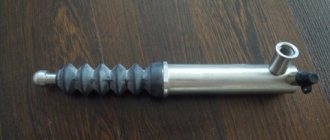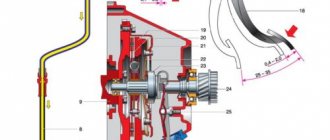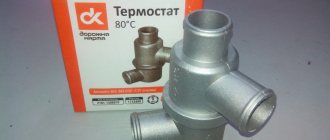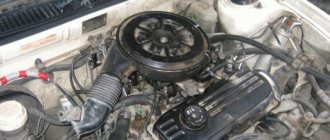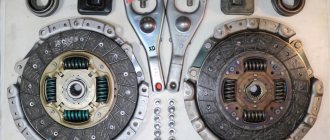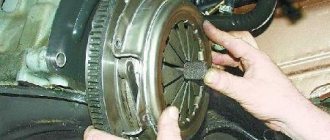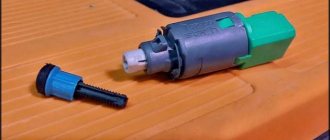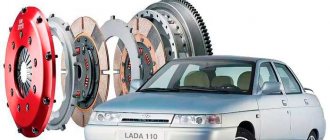Cars admin26.02.2020
Today, the article will talk about procedures such as replacing and adjusting the 2106 clutch with your own hands. As we like to repeat, everything can be done without the help of car service specialists; there are no difficulties in repairing VAZ cars and there cannot be any. Often, drivers try to solve all the problems with the car on their own, because the cost of maintenance is absurdly high.
Even despite the fact that the VAZ 2106 has not been produced for ten years. And we will try to help as much as possible with the repair. If you have any questions, leave comments, share your experience, and describe unusual situations. After all, the topic is quite interesting and rich.
Clutch mechanism of a VAZ 2106 car
Description of design
You all know that the driver's feet have a clutch pedal. For some, this is enough and they don’t go any further. But if you’ve already decided to take on the repair, you’ll have to study the entire rest of the chain. On the VAZ 2106, like on all other classics, the clutch drive is hydraulic. The pedal drives the master cylinder rod, which moves a small piston inside it.
An expansion tank is connected to this cylinder. On 2106 and similar VAZ models it is located on the partition between the engine compartment and the passenger compartment. It is worth noting that on nines and newer cars the expansion tank was installed directly on the cylinder body - a significant saving in space and a slight increase in reliability. After all, rubber tubes tend to wear out and leak brake fluid.
Clutch failure
The clutch can fail for several reasons:
- Resource development.
- Presence of a manufacturing defect.
- Harsh operation.
- Mechanical damage during operation.
Very often, the cause of premature failure of VAZ 2106 clutch elements is the presence of manufacturing defects and increased loads. In particular, traffic jams in the city make themselves felt quite quickly.
Symptoms of malfunctions
Depending on the type of breakdown, the following symptoms may appear:
- The clutch pedal fails, the engine and gearbox shafts do not open.
- The clutch works, but there is an extraneous sound.
- The engine picks up speed, but the speed does not increase - the clutch slips.
- Shifting gears is difficult, the clutch “leads” and does not disengage completely.
- The appearance of leaks from the expansion tank, pipes, cylinders.
It has already been said that the master cylinder is mechanically connected to the pedal. But the clutch fork and slave cylinder are mounted directly on the gearbox. With the help of these mechanisms, the release bearing moves along the axis of the input shaft.
How does the clutch drive work?
The operating principle of the entire clutch drive mechanism on a VAZ 2106 car is as follows:
- The driver presses the pedal.
- The rod moves and along with it the piston in the cylinder.
- The pressure in the pipeline between the main and working cylinders increases.
- Due to the increased pressure in the working cylinder, the piston and rod move, which drives the clutch fork.
After all this, the VAZ 2106 clutch disc and the basket move away from each other, the crankshaft does not rotate the primary one. Therefore, the car does not move. And now about the repair procedure.
Repair of the clutch master cylinder on a VAZ 2106 car
To repair the clutch master cylinder on a VAZ 2106, you will need: a screwdriver, a circlip remover, and tweezers. 1. Remove the master cylinder from the vehicle
2. Place the clutch master cylinder in a vice. Using a screwdriver to carefully pry from several sides, remove the lock washer and remove the fitting from the cylinder body.
3. Change the position of the cylinder in the vice. Carefully pry up the protective cap with a screwdriver and remove it.
4. Squeeze the retaining ring and remove it. In this case, the pusher piston will move out of the clutch cylinder under the action of the spring.
5. Remove the pusher piston from the cylinder.
6. Carefully pry up with a screwdriver and remove the O-ring.
7. Remove the piston from the clutch cylinder by lightly pressing it. The piston will be released from the cylinder under the action of a spring.
8. Use tweezers to remove the spring from the cylinder.
9. Carefully pry up the O-ring with a screwdriver and remove it from the piston.
NOTE Remove the end cap only if absolutely necessary (to replace the gasket under it if a brake fluid leak is detected).
10. Clean the inlet, bypass and outlet holes in the clutch master cylinder. 11. The mirror of the clutch master cylinder (the internal diameter of a good cylinder must be 19.05 mm) and the outer surface of the piston must not be damaged or scratched. 12. Inspect the spring. If there is mechanical damage, replace it. 14. Inspect the protective cap. If there is mechanical damage and signs of rubber aging, replace it. 15. Assemble the clutch master cylinder in the reverse order of disassembly.
NOTE: Before assembly, wash all parts with clean brake fluid. Mineral oil, kerosene, gasoline or diesel fuel must not come into contact with parts (to avoid swelling of rubber parts)
Preparing for repairs
Before putting the car in a pit and removing the box to replace the clutch, you need to visit the store and buy all the necessary spare parts:
- Clutch disc.
- Basket (drive disk).
- Release bearing.
- If necessary, clutch fork.
- If there is significant wear, the crown on the flywheel will also need to be replaced.
- Bolts securing the basket to the flywheel.
It is also important to have a good set of tools on hand, WD-40 penetrating lubricant, sometimes even a gas torch is necessary (if the bolts and nuts are very rusty).
It is advisable to carry out all the work in an inspection pit or overpass (it is unlikely that the average driver of a six will have a lift in the garage, so we do not mention it). If everything goes smoothly and the nuts unscrew well, you will complete all the work very quickly.
Place the car on the pit, fix it in one position by placing stops under the wheels. All work is divided into two stages: under the car and above it. Please note that there is no need to drain the oil, since if you dismantle it carefully, you will not spill a drop.
And don't forget about the alignment of the clutch disc. The price of a special device is quite high - about 500 rubles. but you can use a small piece of pipe without any problems, as long as the diameter is suitable.
Work on top of the car
So, a start has been made, the goal is to remove the gearbox to replace the clutch. On VAZ 2106 and similar cars this is done quite quickly, it is only important to follow a certain sequence:
- Inside the car, remove the gear shift knob. It is attached using plastic latches. Sometimes difficulties arise with dismantling, and it gets to the point where the latches break off. The price of a new set of fastenings is no more than one hundred rubles, and you can purchase it even after repairs have been carried out. Therefore, do not be afraid if you suddenly break the plastic antennae.
- Go to the engine compartment, unscrew the four nuts that secure the exhaust pipe to the manifold. The fact is that the exhaust pipe will interfere with the removal of the box, but it is enough to move it a little to the side.
- Disconnect the battery and remove it from the car.
- Unscrew the two top bolts of the starter, disconnect the power wires for the windings and the solenoid relay from it.
- Disconnect the ground wire that goes to the gearbox.
Work under the car
This is perhaps the most difficult part of the entire repair, since there are many more steps to be taken here. So make yourself comfortable and proceed to the following operations:
- Unscrew the last (lower) nut securing the starter and remove it. This nut is the nastiest, since it is difficult to get to it using simple wrenches; you will need to use a socket, a ratchet and a cardan. True, it was possible to work with an ordinary open-end wrench installed in the end.
- Unscrew the suspension bearing mount.
- Disconnect the cardan and rear axle flange. Hold the bolt head from turning with a 12mm open end wrench.
- Apply sharp blows to the driveshaft to dislodge it from the rubber coupling on the transmission shaft. Move the cardan to the side.
- Unscrew the mounting of the pillow, install a support under the gearbox.
- Remove the slave cylinder from the clutch fork. Be careful not to lose the bar underneath and the spring.
- Remove the speedometer cable.
- That's all, now all that remains is to unscrew the four bolts that secure the box to the engine block.
Remove the gearbox carefully, try to move it as far as possible from the engine block. The fact is that you can damage the VAZ 2106 clutch drive disc. And this is quite easy to do.
If we take nines and newer VAZs as an example, then the clutch drive discs on them are more reliable and durable. It is advisable to set the gearshift lever to the position corresponding to the third speed.
Clutch replacement
Please note that it is imperative to install new clutch basket mounting bolts. On old ones, the threads already have minor deformations, therefore, the connection will be very unreliable. The price of all elements will be approximately 2000-2500 rubles.
If you prefer foreign-made units, it will be more expensive. However, it is worth wondering about a simple truth: the service life of imported ones is sometimes shorter than domestic ones, and the price can be twice as high. Why pay extra money? And in general, if the price of a car is 20-40 thousand rubles, why invest a lot of money in it?
But let's return to the replacement procedure. Unscrew all the bolts from the basket, remove it and the clutch driven disc. Install new elements in the same way, but tighten the bolts, do not tighten them. It is advisable to look at the condition of the crown before installation. If it is deplorable, then you should immediately install a new one.
In stores, its price is about 200-250 rubles, which is not very expensive. But you can reduce the cost of repairs by simply removing the crown, heating it and installing it on the reverse side. But you will have to buy a new one if this procedure was previously performed.
Pay attention to the VAZ 2106 clutch fork; if it is damaged, be sure to replace it. A new release bearing is installed in any case. You can apply CV joint grease to it, for example. This can slightly increase its resource.
Almost finished, all that remains is to take the guide sleeve and install it in the hole of the clutch disc. Without removing the shaft, tighten all the basket mounting bolts crosswise. Do not allow distortions, otherwise the clutch will not work correctly and its service life will decrease.
That's all, the clutch replacement was completed successfully, now all that remains is to assemble the car. But here no difficulties will arise, since all the actions are the opposite of those that were described in detail in this article. If you also need to replace the brake fluid in the drive system, then read on.
Bleeding the system
Draining fluid from the clutch drive system is very simple:
- Using a blower, pump out the liquid from the expansion tank.
- Unscrew the fitting on the working cylinder and wait until all the fluid is gone.
- Press the clutch pedal several times to remove any remaining brake fluid.
- Change tubes if necessary.
- Tighten the fitting.
- Fill the reservoir with fresh brake fluid.
- Place a transparent tube onto the fitting.
- Have an assistant press the clutch pedal several times. With the last press, you need to hold it in the extreme position.
- Unscrew the fitting half a turn, allowing fluid and air to escape.
- Repeat the procedure until liquid begins to flow without air bubbles. Don't forget to monitor the level in the expansion tank.
In fact, two or three passes are enough to get rid of air in the system. As you understand, pumping the clutch on a VAZ 2106 is not difficult. The procedure is very similar to bleeding the brakes, only it is much faster - the line is very short.
After replacing the clutch, it will need to be adjusted. Pay attention to the working cylinder rod - it has a thread along which you can move the nut. It is by moving it that the clutch is adjusted on VAZ 2106 cars and the rest of the classic series. It is also possible to adjust the free play of the clutch pedal; for this purpose, a special bolt is provided directly above it.
You will need: 8 key, screwdriver.
Removing and installing the clutch slave cylinder on a VAZ 2106
Remove the slave cylinder from the VAZ 2106 car for replacement or repair if the clutch is not completely disengaged caused by a fluid leak. To remove the clutch slave cylinder from a VAZ 2106, you will need: keys “13”, “17”, pliers.
1. Loosen the hydraulic hose on the clutch slave cylinder.
2. Disconnect the release spring from the clutch release fork and remove the spring.
3. Remove the cotter pin from the hole in the clutch slave cylinder pusher.
4. Remove the two bolts securing the slave cylinder to the clutch housing.
5. Remove the release spring bracket.
6. Remove the slave cylinder pusher from the clutch release fork.
7. While holding the hose tip from turning and rotating the clutch cylinder, separate them.
WARNING Be careful not to lose the sealing washer.
8. Drain the fluid from the drive and working cylinder into a prepared container. 9. Install the new clutch slave cylinder on the vehicle in the reverse order of removal. 10. Bleed the clutch hydraulic drive
Purpose and operation of the VAZ 2106 clutch slave cylinder
In short, the working cylinder in the VAZ 2106 clutch system performs the function of an ordinary converter. It translates the driver's foot force into high brake fluid pressure in the vehicle's hydraulics.
However, the clutch slave cylinder should not be confused with the main one, because these devices are located in different places on the machine. The main cylinder is located in the passenger compartment, and the working cylinder is attached to the clutch housing with two bolts. Getting to the working cylinder is easy: just open the car hood.
Working cylinder device
The clutch slave cylinder consists of the following elements:
- cast body;
- hydraulic piston;
- pusher rod;
- working spring;
- a pair of ring-shaped sealing cuffs;
- washer and retaining ring;
- air valves;
- protective cap.
Operating principle
The operation of the cylinder begins the moment the car owner presses the clutch pedal connected to the push rod:
- The rod moves and presses on the piston located in the main clutch cylinder. This cylinder constantly contains brake fluid.
- Under the influence of the piston, the fluid pressure increases; it rushes sharply through the hose system to the clutch working cylinder and begins to put pressure on its rod.
- The rod quickly extends from the cast cylinder body and presses on a special fork, which moves sharply and puts pressure on the release bearing.
- After this, the clutch discs disengage, resulting in a complete disconnection of the transmission from the engine. At this moment the driver has the opportunity to engage the required gear.
- When the driver takes his foot off the pedal, everything happens in reverse. The pressure in all cylinders drops sharply, and the return spring pulls the working cylinder rod back into the cast housing.
- The fork is released and goes down.
- With nothing else in the way of the clutch discs, they engage again, connecting the transmission to the engine. The car then moves further in the new gear.
Signs of breakdown
Every owner of a VAZ 2106 should know several important signs that indicate that something is wrong with the clutch cylinder:
- the clutch pedal began to be pressed unusually easily;
- the pedal began to fail (this can occur either from time to time or constantly);
- the brake fluid level in the reservoir has dropped significantly;
- noticeable leaks of brake fluid appeared on the bottom of the car in the area where the gearbox was located;
Fortunately, the clutch cylinder is easy to repair. It is quite rare to change the working cylinder on sixes, and repair kits for them can be found in almost any auto parts store.
Clutch master cylinder
According to its principle of operation, the clutch master cylinder of the VAZ 2106, like its counterparts on other brands, is mounted in the upper position, and acting on it with the corresponding foot pedal entails an increase in pressure in the hydraulic system. As a result, the clutch slave cylinder is activated, and the required vehicle mechanisms are connected.
Signs indicating defects in the six clutch master cylinder:
- incomplete disengagement of the clutch mechanism with the engine (“drives”);
- the presence of leaks from various elements of the system, incl. from under fasteners, rubber products and pipelines;
- “wedge” of the clutch master cylinder when the brake pedal is in a recessed position.
The necessary replacement of the clutch cylinder is carried out in the following order:
- We free the hydraulic drive reservoir from liquid using a special bulb.
- We disconnect the hose and the fitting of the product, having first unscrewed the clamping clamp.
- We dismantle the tube fitting using a wrench set to “13”.
- We dismantle the 2 elements fastening the product to the studs for fastening the foot pedal, using the anchor head at “13”.
- We dismantle the product itself.
- Installation is carried out in reverse order.
- We fill the clutch reservoir with a special fluid and, using pumping, give the hydraulic drive a working condition.
Disassembling the clutch master cylinder for repair work is carried out in the following sequence:
How to remove the clutch slave cylinder
Before you begin repairing the clutch cylinder, it will have to be removed from the vehicle. Here's what you need for this:
- pliers;
- set of spanners;
- set of socket heads;
- empty container for brake fluid;
- rags.
Sequence of operations
It is most convenient to remove the clutch cylinder in the inspection hole. As an option, an overpass is also suitable. If the driver has neither one nor the other, it will not be possible to remove the cylinder. The work is performed in the following order:
- The cylinder return spring is removed manually.
Video: removing the clutch cylinder on a “classic”
Replacing the master cylinder
The work of replacing the clutch master cylinder on a VAZ-2106 is carried out in almost the same way. It is fixed opposite the pedal. The master cylinder rod is connected to the pedal mechanically. The replacement procedure is as follows:
- Drain the brake fluid from the system.
- Unscrew the hose going to the expansion tank.
- Unscrew the tube going to the working cylinder.
- Unscrew the two bolts that secure it to the partition.
After this, the master brake cylinder is removed and repaired or completely replaced.
Bleeding the clutch of a VAZ 2106 with the help of a partner
Replacing the cylinder or any other manipulations with the clutch inevitably leads to depressurization of the hydraulic drive and air getting into the clutch hoses. To normalize clutch operation, this air will have to be removed by bleeding . Here's what's required:
- 0.5 liters of new brake fluid;
- a piece of rubber hose 30 cm long;
- open-end wrench 8 mm;
- empty brake fluid container.
Sequence of work
For normal pumping you will have to use the help of a partner. It is simply impossible to do everything alone.
- When the clutch slave cylinder is repaired and installed in its original place, brake fluid is added to the reservoir. Its level should reach the upper mark located near the neck of the tank.
Repair of the clutch slave cylinder on a VAZ 2106 car
To repair the clutch slave cylinder on a VAZ 2106, you will need: an 8-point wrench and a screwdriver. 1. Remove the slave cylinder from the vehicle. 2. Having installed the clutch slave cylinder in a vice, unscrew the air release fitting.
3. Change the position of the cylinder in the vise. Carefully pry up the protective cap with a screwdriver and remove it along with the pusher.
4. Place the clutch cylinder horizontally in the vise again. Using a thin screwdriver, move the piston until it comes out of the cylinder and remove the piston.
5. Use a screwdriver to pry up the retaining ring on the piston and remove it, holding the spring.
6. Remove the spring from the piston.
7. Remove the washer and first o-ring from the piston.
8. Remove the second o-ring from the piston by carefully prying it off with a screwdriver. 9. Remove the protective cap from the pusher.
NOTES Remove the plug only if absolutely necessary (to replace the gasket under it if a brake fluid leak is detected). Pay attention to the markings on the clutch slave cylinder housing - this will help you make your choice when purchasing auto parts.
10. Clean the holes in the cylinder and air outlet fitting. 11. The clutch slave cylinder mirror and the outer surface of the piston must not be damaged or scratched. 12. Inspect the spring. If there is mechanical damage, replace it. 13. Replace the O-rings. 14. Inspect the protective cap. If there is mechanical damage and signs of rubber aging, replace it. 15. Assemble the clutch slave cylinder in the reverse order of disassembly.
NOTE: Before assembly, wash all parts with clean brake fluid. Contact of mineral oil, kerosene, gasoline or diesel fuel is not allowed on the parts (to avoid swelling of the rubber parts).
How to adjust the clutch rod on a VAZ 2106
After bleeding the working cylinder, it is necessary to adjust the clutch rod. To do this you will need:
- set of open-end wrenches;
- medium-sized caliper;
- pliers.
Adjustment sequence
Before you begin making adjustments, you should look at the machine's operating instructions . It is there that you can clarify all the necessary tolerances for the clutch rod and pedal.
- First, the clutch pedal play (also known as free play) is measured. The most convenient way to measure it is with a caliper. Normally it is 1–2 mm.
- If the free play exceeds two millimeters, then use a 10 mm open-end wrench to unscrew the nut located on the free play limiter. After this, you can turn the limiter itself and set the required free play of the pedal.
Video: how to adjust the clutch drive
Checking and replacing the hose on the clutch cylinder
The hose on the clutch slave cylinder is an extremely critical part that is exposed to high brake fluid pressure. Therefore, the car owner must monitor its condition especially carefully.
Here are signs that indicate that the hose should be changed urgently:
- cracks and other mechanical damage visible to the naked eye have appeared on the hose;
- the hose looks intact, but there are visible leaks of brake fluid on it (this means that it is still damaged and microcracks have appeared on it, which the driver simply cannot see);
- The threads on the hose ends are partially or completely stripped.
If you notice any of the above, the hose should be replaced immediately. It is better to install standard VAZ clutch hoses, their catalog number is 2101–16–025–90, and the cost is about 80 rubles.
Hose replacement sequence
Before starting work, you should stock up on an empty plastic bottle and two open-end wrenches: 17 and 14 mm.
- The car is driven into the pit and secured with wheel chocks. Open the hood and find the place where the slave cylinder hose is screwed to the clutch hydraulic tube.
- The main hose nut is held firmly with a 17 mm wrench, and the fitting on the hydraulic tube is unscrewed with a second wrench - 14 mm. After unscrewing the fitting, brake fluid will flow out of it. Therefore, there should be a container in the inspection hole to collect it (a small basin would be the best option).
- The second end of the hose is unscrewed from the working cylinder body using the same 17 mm wrench. There is a thin O-ring in the cylinder under the hose nut, which is very often lost when removing the hose . This ring should also be changed (as a rule, new seals come with new clutch hoses).
- A new hose is installed in place of the old one, after which a new portion of brake fluid is added to the hydraulic system.
So, even a novice driver can change the working cylinder on a six. All you need to do for this is to carefully prepare the necessary tools and strictly follow the above recommendations.
Operating principle and replacement of the clutch master cylinder
The clutch master cylinder itself serves to transmit the maximum fluid pressure from the foot pedal of this mechanism to the VAZ 2106 clutch slave cylinder, forcing it to move within the required limits in its plane. As has already been noted, the transmission of the pressure force of the foot drive through the clutch master cylinder entails an increase in the pressure parameters in the hydraulics of this complex.
Next, the system pressure is transmitted to the clutch slave cylinder, which drives the vehicle’s transmission. However, there are defects that require repair and replacement of the GCS and RCS. This can be determined if the following signs are present:
- The drive unit of the system does not completely disengage (the clutch “drives”).
- Leakage of working fluid from the components of the unit, incl. from hydraulic pipes and their connections.
- “Wedging” of the clutch master cylinder when the foot drive is in the lowest (recessed) state.
Timely replacement of the VAZ 2106 clutch cylinder is done in the following sequence:
- Use a bulb or other device to pump out the working fluid from the clutch hydraulic reservoir.
- Having loosened the fastener in the form of a crimp clamp, disconnect the hydraulic hose from the drive fitting.
- Unscrew the pipeline drive fitting using a “13” wrench.
- Unscrew the 2 nuts of the studs securing the foot clutch drive using a socket set to “13”.
- Carefully remove the GCS.
- When installing an updated product, assembly is carried out in reverse order.
- We pour special fluid into the hydraulic tank and pump the hydraulic system.
- We remove from the end part the cap for the protective function of the VAZ 2106 clutch cylinder, the price of which is low, which protects this spare part from mechanical deformation.
- Use a screwdriver with a thin blade or an awl to remove the lock washer-gasket and dismantle the fitting device with the seal.
- Having installed the clutch master cylinder in a vice on a bench, use a 22mm wrench to unscrew the plug.
- We take out the retaining ring and the remaining elements of the GCS.
- We inspect in detail the components of the GCS: the “mirror” of the product and the piston outer surface must be smooth, without burrs. The return element must have the necessary rigidity, otherwise it will need to be replaced. The sealing o-rings must be replaced with updated products, as well as the protective cap. If the lock washer of the fitting device is defective, it must also be replaced.
- We wash all the elements of the GCS with a degreaser solution, after which we assemble the product into a single whole.
in this video I change the clutch master cylinder
for
VAZ
2107. similarly,
the master cylinder is replaced
...
Operating principle and replacement of the clutch slave cylinder
If a car owner is replacing the clutch slave cylinder of a VAZ 2106, then it is necessary not only to prepare a set of plumbing tools, cleaning and degreasing products. It is required to have sufficient skills in plumbing, to imagine the structure of the product being dismantled and to have the desire to make such a replacement.
Dismantling the clutch slave cylinder is carried out according to the following algorithm:
- Starting the dismantling process, it is necessary to slightly loosen the screw securing the rubber hydraulic tube, which leads to the connection with the clutch slave cylinder of the “six”.
- We remove the spring mount that pulls back the clutch fork, and then dismantle it.
- We fix the location of the pusher element of the clutch working cylinder, and then remove the cotter pin.
- Remove the bolted connections of the clutch slave cylinder to the vehicle's clutch housing.
- Remove the spring-type pull-out bracket and remove the pusher element from the mechanism fork.
- The next stage is the removal of the clutch pipeline from the control center, this requires fixing the front tip from rotation, while using a circular motion we dismember the connecting element from the control center.
- Then we remove the sealing washer, which during further assembly of the product must be replaced with an updated product, because its reuse is unacceptable.
- After this, we substitute an empty tank to place the liquid in it, which circulates in the hydraulic drive of the mechanism.
